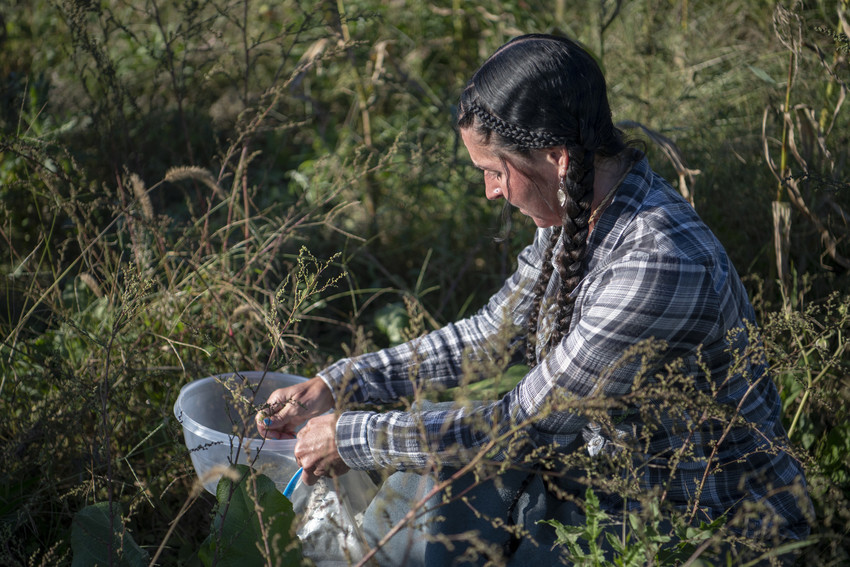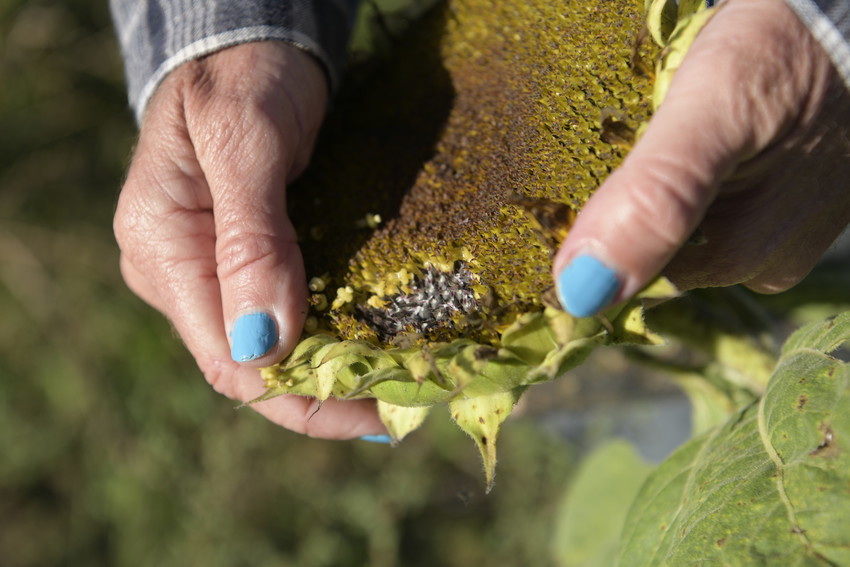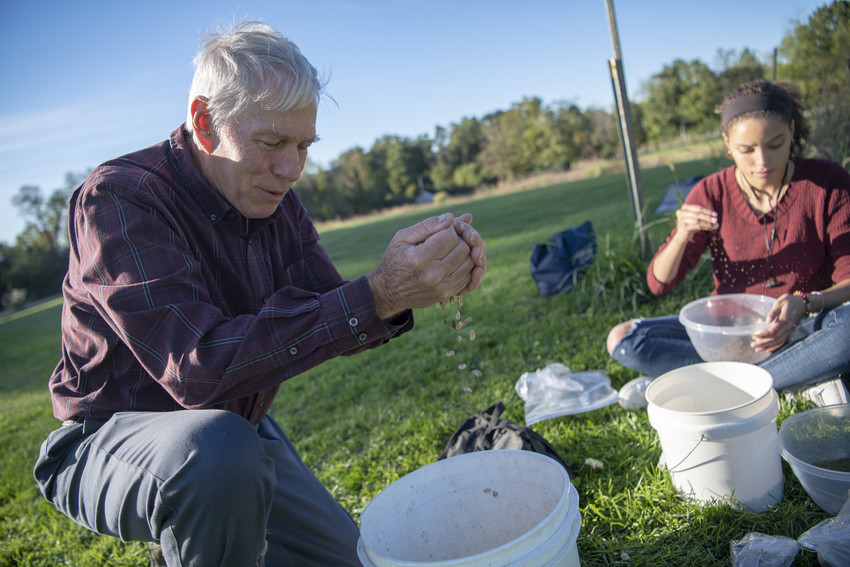
LET IT GROW: May Hey, InclusiveVT faculty fellow, collects seeds from various plants grown in the Indigenous garden.
Tucked away amid the immaculate landscaping of Virginia Tech’s Turfgrass Research Center grows a garden. Although viewers from Southgate Drive might mistake the growth for an unmown patch of weeds, this garden is a haven for Indigenous plants, seed repatriation, and the building of community.
Established by Sam Cook, director of American Indian Studies, and John Galbraith, associate professor in the Department of Crop and Soil Environmental Sciences, the Indigenous garden was cultivated as part of a 2014 class. With steady guidance from elders Vicky Ferguson, a Monacan Indian and interpreter at Natural Bridge State Park, and Jeffrey Kirwan, professor emeritus and forestry Extension specialist in the College of Natural Resources and Environment, the garden has become not just a place to grow Native species but to cultivate relationships.
Sunflowers, Seminole pumpkins, patty pan squash, cushaw, cornfield beans, Cherokee purple tomatoes, and multiple varieties of potatoes propagate the green space alongside wilder “volunteer” species, such as lamb’s quarters and ground cherry.
At a special gathering last fall, members of the students organization, Native at Virginia Tech, alumni, and parents joined Kirwan and Mae Hey ’17, an InclusiveVT faculty fellow, who is also a postdoctoral fellow in American Indian Studies, faculty fellow with the Leadership and Social Change Residential College, and an Indigenous community liaison for the Office for Inclusion and Diversity. The small group assisted with the harvest of Tutelo strawberry corn as part of a repatriation project, “meaning it’s a citizen returning to its homeland,” Hey said. None of the seeds for the garden are purchased, but come from seed exchanges.
“We are keeping the traditions of the ancestors through sharing our seed relatives among our communities. This practice reminds use that the seeds are autonomous beings and gifts that coevolve with us, nurturing our wellness, rather than commodities that can be bought and exploited,” said Hey.

Hey collects seeds from the heads of sunflowers.
A portion of the harvest is shared with local food banks through the New River Valley Glean Team.
In tandem with the creation of the American Indian and Indigenous Community Center in Squires Student Center, the garden has become a venue for an active, growing population of Native students. Together, the students are powering efforts to build a bigger Indigenous community at Virginia Tech by participating in outreach efforts to state tribes as well as organizing spring powwows in 2017 and 2018.
Lee Lovelace ’09, tribal outreach liaison with undergraduate admissions; Hey; and students in Native at Virginia Tech travel around the state to visit Virginia tribes at festivals, powwows, and other events. The students build connections with Virginia tribes while also acting as ambassadors for Virginia Tech. By engaging with Native middle and high-schoolers during these visits, the students are not only ambassadors for the university but also examples of the talented students that Tech attracts, modeling the college experience for young people who might be the first from their families to attend college.

Jeffrey Kirwan demonstrates winnowing, an agricultural method developed by ancient cultures to separate grain from chaff.
The effort reflects Virginia Tech’s motto of Ut Prosim (That I May Serve) and the land-grant mission to serve the public.
Until recently, members of Virginia tribes had not been officially recognized by the federal government. Six Virginia tribes—the Chickahominy, Eastern Chickahominy, Upper Mattaponi, Rappahannock and Nansemond Tribes, and Monacan Indian Nation—were federally recognized in January 2018. The Pamunkey tribe was recognized in 2016.
Virginia Tech’s rejuvenated outreach efforts honor those tribes and their long histories and address President Tim Sands’ goal that 40 percent of Tech’s student body be made up of underrepresented, first-generation, or lower-income students by 2022.
“Let’s not forget the fact that we have 11 tribal communities in this state, as well as the fact that Tech sits on Monacan Nation land,” said Melissa Faircloth, director of the American Indian and Indigenous Community Center, whose work as a Diversity Scholar led to the powwows at Virginia Tech. “Those students should feel like this is their university, that there is opportunity here for them.”
As with the Indigenous garden amid the turf, these students are increasingly finding room to grow.
